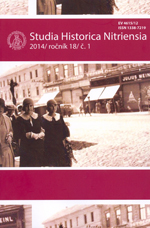Studia Historica Nitriensia, 2014, roč. 18, č. 1:
Obsah/Contents/Inhalt
Štúdie a články/Articles/Studien
Author: Bahenská Marie
Author: Kičková Adriana
Title: Ženy a štruktúra československého ministerstva zahraničia
Author: Malínská Jana
Title: České politické strany a jejich (ne)ochota podílet se na řešení ženské otázky (1860–1914)
Author: Musilová Dana
Title: Ženy v intelektuálních profesích v první polovině 20. století
Author: Nečasová Denisa
Title: Veřejná sféra a genderová analýza po únoru 1948: příspěvek do diskuze
Author: Sozanská Nina
Title:Verejná odborná škola pre ženské povolania v Nitre a jej činnosť v rokoch 1939-1945
Materiály/Materials/Materialien
Author: Prelovská Daniela
Title: Žilinský Zjazd Zväzu slovenských múzeí z 20. decembra 1945
Rozhľady/Horizons/Horizonte
Authors: Al-Absiová Eva – Al-Absi Marwan
Title: Verejné sféry arabskej ženy (Tradicionalizmus verzus arabské myslenie)
Author: Čechová Mariana
Title: Sophiina predestinácia v klasických naratívoch (Cinderella) a v pojmových modeloch (M. R. Coxová)
Author: Karlíková Janka
Title: Dáma s fotoaparátom (Zo života a tvorby významnej fotografky Márie Holoubkovej-Urbasiówny)
Author: Pintérová Beáta
Title: Osudy Šarloty Hevessy – pedagogičky v Podzoborskom regióne
Author: Szekeresová-Kovácsová Judita
Title:Príbeh Izabely Bošňákovej rodenej Péterovej
Anotácie/Annotations/Glossen
BYSTRICKÝ, Valerián – ROGUĽOVÁ, Jaroslava (eds.). Storočie procesov. Súdy, politika a spoločnosť v moderných dejinách Slovenska. (Zuzana Hasarová)
Kodžiki. Kronika dávneho Japonska. (Róbert Hegedüs)
VORAGINE, Jakub de. Legenda aurea a Čechy. (Ján Jakubej)
Kronika/Chronicle/Chronik
